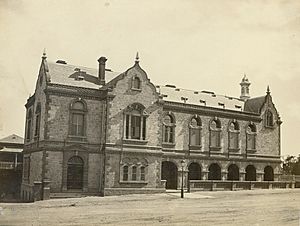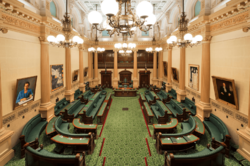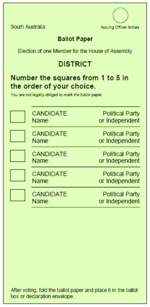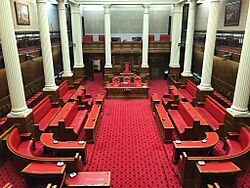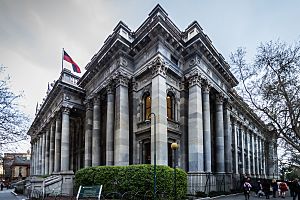Parliament of South Australia facts for kids
Quick facts for kids Parliament of South Australia |
|
|---|---|
| 55th Parliament | |
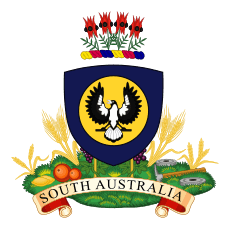
|
|

Parliament of South Australia logo
|
|
| Type | |
| Type | |
| Houses | Legislative Council House of Assembly |
| History | |
| Founded | 22 April 1857 |
| Leadership | |
|
Frances Adamson
Since 7 October 2021 |
|
|
Speaker of the House of Assembly
|
Leon Bignell, Independent
Since 11 April 2024 |
|
President of the Legislative Council
|
Terry Stephens, Liberal
Since 3 May 2022 |
|
Peter Malinauskas, Labor
Since 21 March 2022 |
|
|
Leader of the Opposition
|
David Speirs, Liberal
Since 19 April 2022 |
| Structure | |
| Seats | 69 47 MHAs 22 MLCs |
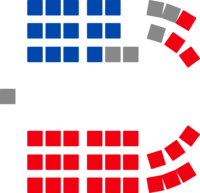 |
|
|
House of Assembly political groups
|
Government (27)
Labor (27) Opposition (14) Liberal (14) Crossbench (6) Independent (6) , with Cregan serving in the Cabinet) |
 |
|
|
Legislative Council political groups
|
Government (9)
Labor (9) Opposition (8) Liberal (8) Crossbench (5) Greens (2) One Nation (1) SA-BEST (1) Independent (1) |
|
Length of term
|
House: 4 years Council: 8 years |
| Elections | |
|
House of Assembly voting system
|
Instant-runoff voting |
|
Legislative Council voting system
|
Single transferable vote |
|
Last general election
|
19 March 2022 |
|
Next general election
|
21 March 2026 |
| Redistricting | Redistributions are carried out after each election by the South Australian Electoral Districts Boundaries Commission. |
| Meeting place | |
 |
|
| Parliament House, Adelaide, South Australia, Australia |
|
| Constitution | |
| Constitution of South Australia | |
The Parliament of South Australia is the main law-making body for the state of South Australia. It has two parts, like two teams working together. One part is the 47-member House of Assembly, also known as the lower house. The other part is the 22-member Legislative Council, or upper house.
Every four years, elections are held. All members of the lower house are chosen, and half of the upper house members are elected. This system of government is similar to the one used in the United Kingdom, called the Westminster system. It means that the government leaders must also be members of parliament and have the support of the House of Assembly. The parliament meets at Parliament House in Adelaide, the state capital.
The Constitution of South Australia explains how the parliament works. It gives the parliament the power to make laws for South Australia. The Governor of South Australia also plays a role, approving laws after both houses agree. The parliament can also investigate issues, do research, and ask people to provide information.
Contents
History of South Australia's Parliament
Early Days and First Parliament
When South Australia was first set up in 1834, it was governed by a Governor and a Resident Commissioner. They had a council that made laws and managed money. This council was sometimes called the "Legislative Council."
In 1842, a new law changed how South Australia was governed. It became a Crown Colony, meaning the British Government had full control. A new Legislative Council was created, with members chosen by the British Government. This was South Australia's first real parliament. It met in a special building on North Terrace, which is now known as "Old Parliament House."
Becoming More Democratic
In 1850, a big step was taken when the British Government allowed colonies like South Australia to create their own constitutions. This meant they could set up more democratic parliaments. In 1851, elections were held for the Legislative Council. It had 24 members: some chosen by the Governor and 16 elected by people who owned property.
In 1853, the Legislative Council wanted to create a new parliament with two houses. They thought the British Government would only accept an upper house where members were chosen for life. But the Governor knew this wasn't true. The colonists were very upset and asked for two elected houses.
So, in 1855, a new Legislative Council was elected. Their job was to create a much more democratic system. This led to the Constitution Act 1856. This act officially set up the Parliament of South Australia with two elected houses.
After Australia Became a Nation
In 1901, South Australia joined with other British colonies to form the Commonwealth of Australia. This meant some of the Parliament of South Australia's powers were given to the new federal parliament. Also, many talented politicians moved to work in the federal government.
The number of members in the House of Assembly changed over time. It started with 36 members in 1857 and grew to 54 by 1890. After Australia became a nation, the number was reduced. The second part of the "New Parliament House" building was finally finished in 1939, 50 years after the first part.
The "Playmander" Years
A unique part of South Australia's history was the "Playmander" from 1936 to 1968. This was a system where voting areas were drawn unfairly to give more power to rural areas. Even though rural areas had fewer people, they had more members in parliament. For example, in 1968, one rural area had only 4,500 voters, while a city area had 42,000 voters, but both elected one member.
Because of this system, the Labor Party often won more votes across the state but struggled to win enough seats to form the government. They only managed to form government once during this time, in 1965.
After 1968, fairer boundaries were put in place. Since 1975, an independent group called the South Australian Electoral Districts Boundaries Commission has been in charge of drawing these boundaries. Now, voting areas are redrawn after every election to make sure each area has about the same number of people.
Changes to the Legislative Council
The Legislative Council also changed over time. At first, it had 18 members elected from across the whole state. Later, it was split into four voting areas, but these also favored rural areas. The number of members in the Council also varied, from 24 to 18, then to 20.
From 1975, the Council grew to 22 members. Half of them (11) are elected every four years by the entire state.
For a long time, only men who owned property could vote for the Legislative Council. But in 1973, the Labor government led by Don Dunstan changed this. Now, everyone who can vote for the lower house can also vote for the upper house. Since then, no single political party has had full control of the Legislative Council.
How Elections Work
Originally, people voted by choosing as many candidates as there were spots to fill. Later, in 1929, they started using a system called instant-runoff voting. This means voters rank candidates in order of preference.
In 1973, the Legislative Council started using proportional representation, which helps smaller parties win seats. In 1982, this changed to the single transferable vote system.
Voting became compulsory for the House of Assembly in 1942 and for the Legislative Council in 1985. Elections used to be every three years, but since 1985, they are held every four years. The election date is now fixed for the third Saturday in March every fourth year.
House of Assembly: The Lower House
The House of Assembly has 47 members. Each member is elected from a specific voting area, called an electorate. These electorates are designed to have roughly the same number of voters. If a member leaves office early, a special election called a by-election is held to fill their spot.
An independent group, the South Australian Electoral Districts Boundaries Commission, sets the boundaries for these voting areas. They redraw them after every election to keep things fair.
The political party or group that has the most support in the House of Assembly forms the government. Their leader becomes the Premier. The House is led by a Speaker, who must be independent of political parties during their time in office.
Most of South Australia's population lives in Adelaide. This means that the city areas often decide the outcome of elections.
The House of Assembly usually serves a fixed four-year term. However, the Governor can call an early election if the government loses the support of the House or if an important bill is rejected by the Legislative Council. Both houses can also be dissolved early in a "double dissolution" to solve major disagreements.
Legislative Council: The Upper House
The Legislative Council has 22 members, called MLCs. They are elected by the entire state using a system called single transferable voting. Members usually serve for eight years. Elections for the Legislative Council are staggered, so 11 seats are up for election every four years, at the same time as the House of Assembly elections.
If an MLC leaves office early, their replacement is chosen by members of both houses of parliament. If the MLC was part of a political party, their replacement usually comes from the same party.
The Legislative Council has almost the same powers as the House of Assembly. The main difference is that it cannot start or change bills that deal with money or taxes. However, it can still suggest changes to these bills and can reject them if it disagrees.
The main job of the Legislative Council is to review laws that have been passed by the House of Assembly. This can sometimes lead to disagreements if the upper house rejects important laws. The Legislative Council also checks on the government's actions, both in the chamber and through special committees. Because of its voting system, the Council often has members from many different parties, meaning no single party usually has full control.
Solving Disagreements Between Houses
If the two houses disagree on a bill, the South Australian Constitution has a way to solve these "deadlocks."
If the House of Assembly passes a bill, and the Legislative Council rejects it twice (once in one parliament and again after a general election), the Governor can take action. The Governor can either:
- Ask for an election of two extra members for the Legislative Council.
- Dissolve both houses at the same time and call for a completely new parliament. This is called a double dissolution.
A double dissolution means all 22 members of the Legislative Council would be up for election. Although this process has been considered, it has never actually been used in South Australia.
Sometimes, the parliament uses a "Conference of Managers." This is a meeting where a few members from each house discuss and try to find a compromise on bills they disagree about. They then report their suggestions back to both houses.
State First Nations Voice
South Australia has a special body called the Indigenous Voice to Parliament, set up by the First Nations Voice Act 2023. This Voice helps represent Indigenous people to the state parliament and government.
The state is divided into six regions. In each region, Indigenous voters elect a "Local Voice" with an equal number of men and women. These local voices then choose one male and one female member to be their leaders on the "State First Nations Voice." The State Voice then elects its own male and female leaders. These leaders can enter either house of parliament to speak about bills that are important to Indigenous peoples in South Australia. They cannot vote on laws. The State Voice can also talk directly with the state government.
Location of Parliament House
The Parliament of South Australia meets at Parliament House in Adelaide. It's located at the corner of King William Street and North Terrace. This building was built to replace the old, crowded Parliament House, which was built in 1843.
Because of money problems, the current Parliament House was built in stages over 65 years, from 1874 to 1939. After the new building was finished in 1939, the Old Parliament House was used for different things, like government offices and a museum. Since 1995, it has been used again by the parliament for offices and meeting rooms.
Images for kids


